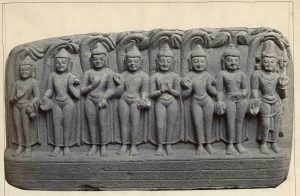
Bodhgayā (बोधगया) Chinese inscription (INCH0005) on a slab (OBCH0005) with the seven Buddhas (saptatathāgata 過去七仏) and Maitreya (弥勒仏). Edition here that of Bagchi and Ta-Fu (2011), see Concordance for bibliographic data. Working transcription (02/2021).
大漢國僧志義先發願勸三十萬人修上生行,施三十萬卷上生
經,自誦三十萬卷:如上功德,向回同生內陀。今至摩竭國,金
剛座,伏遇唯識座主歸寶與諸大德等同發願往生內陀。三十萬人
中,歸寶為第一人,志義第二,廣峰第三,下依?次第:惠嚴,
重達,全遵,緣真,義暹,惠秀,智永,奉升,清蘊等,並願親
奉彌勒慈尊。今結良緣,成此七佛已,為記之。
TRADUCTION: Le religieux Tche-i, du pays des grands Han, avait autre-fois formulé le voeu d’engager trois cent mille hommes à pratiquer la conduite qui assure la naissance supérieure, de répandre au nombre de trois cent mille chapitres les sûtras qui procurent la naissance supérieure, de réciter lui-même ces trois cent mille chapitres; d’un mérite tel que celui qui vient d’être nommé, l’effet en retour est égal à la cause qui fait naître. Maintenant, arrivé dans le royaume de Magadha, il a admiré le trône de diamant, il a passé humblement de· vant le trône du Yijnânamâtra (唯識座). Le maître Koei-pao et une foule de bhadantas ensemble [ont obtenu?] la cause qui fait aller naître; des trois cent mille hommes, Koei-pao fut le premier; Tche-i, le second; Koang-fong, le troisième; au-dessous d’eux s’appnyant lui assure un mérite éclatant, Hoei-chan, catégorie… (?), pémétrer l’oeuvre efficace de la doctrine accomplie; le sens de cela jour plus proche. — Hoei-sieou, Tche-yong, Fong-cheng, Ts’ing-yun et d’autres avaient tous ensemble désiré s’acquitter personnellement soin de sculpter [l’image du] Vénérable Compatissant (= Maitreya); maintenant ils ont accompli cette excellente oeuvre, et, après avoir achevé ces sept Buddhas, ils on fait….